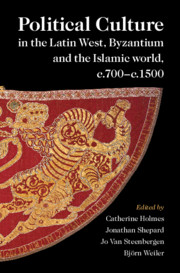 Political Culture in the Latin West, Byzantium and the Islamic World, c.700–c.1500
Political Culture in the Latin West, Byzantium and the Islamic World, c.700–c.1500 from Part V - Conclusions
Published online by Cambridge University Press: 11 August 2021
The spheres’ fifteenth-century political cultures are compared with earlier periods. The west was catching up, with increasingly complex and documented administration. It also saw more lay literacy and political participation by broader bands of actors, with assemblies approving general taxes. Debate was possible in the other two spheres: Islam generally allowed for multilateral discussion on religious law, while ideals of governance were debated in late Byzantium. The west fractured along religious lines to an extent not seen elsewhere: once the clerical monopoly of divine mediation had been fundamentally challenged, the plethora of arms-bearing, landed elites perpetuated conflict. State monopoly of violence characterised Byzantium, while in the Nile-to-Oxus region, ‘men of the sword’ tended not to wage sectarian war. Around 1500, women seldom exercised formal sovereignty. But the centrality of the household as a basic social unit gave them extensive informal power. Charitable foundations were another stabiliser across the spheres. Byzantium’s Muscovite offshoot would expand, but the Ottomans’ disciplined militarism looked invincible against the fractious westerners.
To save this book to your Kindle, first ensure [email protected] is added to your Approved Personal Document E-mail List under your Personal Document Settings on the Manage Your Content and Devices page of your Amazon account. Then enter the ‘name’ part of your Kindle email address below. Find out more about saving to your Kindle.
Note you can select to save to either the @free.kindle.com or @kindle.com variations. ‘@free.kindle.com’ emails are free but can only be saved to your device when it is connected to wi-fi. ‘@kindle.com’ emails can be delivered even when you are not connected to wi-fi, but note that service fees apply.
Find out more about the Kindle Personal Document Service.
To save content items to your account, please confirm that you agree to abide by our usage policies. If this is the first time you use this feature, you will be asked to authorise Cambridge Core to connect with your account. Find out more about saving content to Dropbox.
To save content items to your account, please confirm that you agree to abide by our usage policies. If this is the first time you use this feature, you will be asked to authorise Cambridge Core to connect with your account. Find out more about saving content to Google Drive.